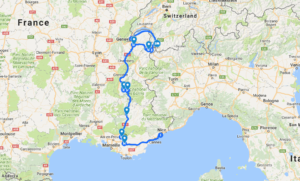What Do I Do for Serra?
In the latest edition of Serra Connects I have written a bit more about what my position at Serra International consists of. I have copied it below.
Serra’s Third Objective and the Internet
In 1934, four Catholic businessmen, Harold Haberle, Daniel Rooney, Leo Sharkey and Richard Ward would begin what was to become known as Serra International or more recently as “Serra”. They organized weekly luncheon meetings for professional men to exchange ideas on Catholic thought, and labeled this the “University of Christian Principles,” though it was far from a university as such. During these informal meetings, they became conscious of the need to set up an organization that encouraged the spiritual growth of its members, and worked to strengthen Catholicism in modern society. However, over the next few months, the founders came to the conclusion that the group that began to grow around them should also devote itself to a worthwhile Catholic objective. After seeking the advice of their bishop, the Most Reverend Gerald Shaughnessy, he helped them determine what that purpose should be – what Serra would eventually become famous for throughout the world – members of the Catholic lay faithful helping to promote and foster vocations to the sacred priesthood.
In 2005, Serra amended its objectives and purposes as follows:
• To foster and promote vocations to the ministerial priesthood in the Catholic Church as a particular vocation to service and to support priest in their sacred ministry;
• To encourage and affirm vocations to consecrated religious life in the Catholic Church; and
• To assist its members to recognize and respond in their own lives to God’s call to holiness in Jesus Christ and through the Holy Spirit.
This third objective is a reflection of the original purpose of the organization. In 2009, Serra’s episcopal adviser, Archbishop (now Cardinal) Timothy Dolan asked what is Serra doing to meet its third objective. That eventually lead to the creation of my current position of assistant director, focusing on research and communications. Much work is to be done.
At Serra’s 70th international convention in Providence Rhode Island this year, I spoke about just this–how we are going to meet the third objective from the perspective of communication. Here at Serra headquarters in our Chicago office, there is only so much we can do on a day to day basis. First, in order to pursue holiness, it is important to be able to recognize Christian principles. Second, we must consider the next step after recognition: response. Lastly, we will take a closer look at how effectively our communication is being done to bring about this recognition and response.
Assistance to Recognize
In order to recognizeChrist’s call in our lives we have to ask: What is the call to holiness? Living holiness can take very many forms in our Catholic tradition–as a Serran, lay person, a priest, steelworker, Dominican, mother or father. However, there are many aspects which are universal.
When recognizing Christian principles, three ideas are important to understand. First, all decisions, which are the basis of defiance to or compliance with the will of God, begin in the intellect. Holiness consists in choosing God, not just in a general way but in daily words and deeds of our lives. Love is not abstract, it comes down to picking that thousandth sick man up off the street as Mother Teresa once said. She said she never would have picked that man up if she had not picked up the first man. The knowledge that this was the correct action the first time was what allowed her to choose to do it, rather than her feelings of revulsion. Therefore one could say that having a properly informed intellect as a Christian is not only helpful to our spiritual lives in the pursuit of Christian holiness but also one could say that it is essential, given that many of the things that we should do, we will not instinctively want to do.
I believe that the best way to sum up holiness is in the old Latin maxim “Salus animarum suprema lex” or, the salvation of souls is the highest law. Many recent groups unfavorable to Tradition would downplay the phrase as something from the “medieval church” as though it does not belong in our present day Catechism. It is important to recognize that this is not only a heresy called “modernism”, the idea that doctrine can evolve and change based on the century in which it is interpreted even to contradict itself later on, but also this is clearly incorrect because the idea is merely another way of stating what Christ Himself stated. In Matthew’s Gospel (22:26-40) we find: “Teacher, which is the greatest commandment in the Law?” Jesus replied: “Love the Lord your God with al l your heart and with all your soul and with all your mind. This is the first and greatest commandment. And the second is like it: Love your neighbor as yourself. All the Law and the Prophets hang on these two commandments.” To love in this way requires a daily decision and recommitment of oneself to the good of the beloved. To love someone is to want their salvation which is the highest good–union with God.
l your heart and with all your soul and with all your mind. This is the first and greatest commandment. And the second is like it: Love your neighbor as yourself. All the Law and the Prophets hang on these two commandments.” To love in this way requires a daily decision and recommitment of oneself to the good of the beloved. To love someone is to want their salvation which is the highest good–union with God.
 l your heart and with all your soul and with all your mind. This is the first and greatest commandment. And the second is like it: Love your neighbor as yourself. All the Law and the Prophets hang on these two commandments.” To love in this way requires a daily decision and recommitment of oneself to the good of the beloved. To love someone is to want their salvation which is the highest good–union with God.
l your heart and with all your soul and with all your mind. This is the first and greatest commandment. And the second is like it: Love your neighbor as yourself. All the Law and the Prophets hang on these two commandments.” To love in this way requires a daily decision and recommitment of oneself to the good of the beloved. To love someone is to want their salvation which is the highest good–union with God.In order to live for the salvation of souls (including our own), we must be able to recognize more opportunities to decide to love-opportunities to build virtue. In the same way that taking a driver’s education course is not necessary to be able to physically drive a car with a manual transmission (trial and error), so too learning the philosophical foundations for theology is not essential nor is theology necessary to become holy. Neither is a coach necessary to play soccer or a hunter safety course needed to hunt. So why would a spiritual director or book be needed for the spiritual life? Reading and spiritual direction are needed more than ever and Serrans, given the importance of their mission, ought to seek them out in local areas.
The means available to Serra headquarters in assisting with the third objective fit conveniently with our discussion on the importance of the intellect. Part of my goal in fulfilling this objective is to communicate the often times dense philosophical and theological teachings of Holy Mother Church and its Tradition (Christ as the official source) in a more distilled way relevant to Serrans (recognize the call) in order that it bear fruit in their own lives (respond to the call).
The second important idea is that it is necessary to recognize that Christian principles are the theological underpinning of our spiritual lives. Consider how differently you would live your life if you misunderstood the theological principle that grace builds upon our nature and instead believed that it is actually what saves us. You would probably receive the sacraments thinking that the sacraments themselves save you, rather than the decisions that you make being aided by the grace that you received from the sacraments. Or consider how you might act if you believed that the Pope directly communicates with God… Or that he has no special inspiration from the Holy Spirit at all? You would either treat him like God Himself or you would not give any more consideration to him (or to his teaching) than you would to a wise spiritual director . These theological confusions that can occur in the intellect, though in cases of true ignorance our culpability is reduced, still cause us to live at the least imperfectly. Our fallen nature (incapability or misunderstanding in this case) takes us away from God, the direction we do not want to go. Thanks to the Magisterium established by Christ, theological principles do not need to be controversial though they often are. On most topics that are controversial, the Church has already taken a clear stance/definition. And if it is not clearly defined, likely it is not very relevant to how we live, but rather abstract–for example how did the Virgin birth actually come about? We as Serrans need to do our part to promote authentic Christian te
 <!–[if gte vml 1]>
<!–[if gte vml 1]>

 <!–[if gte vml 1]>
<!–[if gte vml 1]>
|
The blog logo |
<![endif]–>![]() aching that is loyal to His Church.
aching that is loyal to His Church.
Particularly important for us to understand as Serrans is that there is a greater and greater misunderstanding of the role that Christ’s Church plays in the world and a devaluing of the priesthood itself due to an almost anti-clerical theology that arose in recent decades. Sources for a proper understanding should be Council documents, encyclicals, lives of the saints and Sacred Scripture, rather than the latest book of a theologian or the National Catholic Reporter opinion column.
The third important idea is to recognize that Christian principles are the philosophical underpinnings of Christian theology. Some of you may wonder what philosophy has to do with spiritual ‘fuel’ or theology. It is essential. The reason that recently the Holy See increased the amount of philosophy that candidates for the priesthood need to study by six semester hours was its recognition that most of the theological problems in the Church today are resulting from so called “post-metaphysical” philosophy–a belief that absolute truth cannot be known by us and that modern science is the only way to know something about the world. Philosophy is the interlocutor between Christian faith and secular thinking, Muslims and Buddhists because it is what all intelligent beings have in common -which is logic and thought itself. I would recommend taking a look at the following two documents for more details: Aeterni Patris (1879), The Decree on the Reform of Ecclesiastical Studies of Philosophy (2011).
Today secularism appears to be a major threat to Church vocations. It is a philosophy. The founding principles of secular humanism and scientism in the 17th century, despite their claim to the opposite, lack reasonability. The Serran “University of Christian Principles” could help prevent the contraction of Church vocations in the face of growing secularism by using the very thing secularists claim to monopolize: rationality… perhaps without even mentioning a word about God. One can only imagine how many Catholic young men, unaware of their calling to the priesthood, headed down a different path when they heard from their university philosophy professor that “God is an illusion.” Example sources of philosophy are Plato, Aristotle, St. Augustine, Duns Scotus, St. Thomas Aquinas and G.K. Chesterton.
Assistance to Respond
The second part of meeting the third objective is to assist Serrans to respond to the newly recognized call. Remembering that holiness is care and concern for the salvation of souls, what ways can assistance be given to our members to accomplish this outside of their own revelations for themselves? A famous scholastic principle is “a cause must be greater than or equal to its effect.” Considering the fact that we are to care about the salvation of other souls in addition to our own, you cannot give what you do not have.
I view assistance taking place in this area by suggesting opportunities to practice and apply the newly recognized Christian principles. For example, have you ever wanted to learn Lectio Divinaor Gregorian Chant? I have written a guide on my blog. Have you prayed Serra’s “Eucharistic Adoration for Priestly Vocations”? After I designed it and it’s production was made possible by a very generous donor in Singapore, the book has reached the most and least recognized places of prayer in the Catholic Church. But just the fact that it sits in those places is only one step of the way there. The response consists in praying it just as reading about the virtue of charity is not building the virtue of charity.
Another way that we might assist in responding to the call is by organizing events online. Because of the change in the technology of communications taking place every month, the distance between individuals gets smaller and smaller. Have you ever heard of an event sponsored by a Serra Club or other organization which you found out about after the fact? Have you ever wanted to tell as many people as you could about an event but could not get the contacts? Send the event to me and I can informally announce it on the Serra Facebook page or other medium that has been created. Technology can be used for good or ill and so it is important to get the best use out of it for good that we can. God knows there are enough opportunities being taken advantage of to use it for ill.
What Has Been Done So Far
In order to grow, Serrans must look onward and outward towards Christ coming from the East as well as towards those behind them who do not know Christ or are also journeying towards Him. These should be invited to follow Christ, perhaps to join Serra’s ranks. In recent decades there has been an emergence of a new almost vicarious type of community which cannot be ignored: the online community. For Christians this has the advantage of giving community to those who are isolated in their faith socially or geographically and are looking for a place to share. I know that many youth, though it is in a less perfect way, are online in Catholic pages, forums, blogs seeking a support system in their faith because they cannot find it where they live.
Prospective younger Serrans would not only want online community with Serra, but one can plausibly argue they need it in order for Serra to stay in their consciousness or become part of their life. In fact for almost any topic that a person today can think about, an online “community” sharing this interest is available to support that interest. This is the very reason that Facebook became such a successful undertaking.
In order to accomplish the above mentioned goals, communication from intellect to intellect is required. Please consider the following quote:
“I would like then to invite Christians, confidently and with an informed and responsible creativity, to join the network of relationships which the digital era has made possible…The web is contributing to the development of new and more complex intellectual and spiritual horizons, new  forms of shared awareness. In this field too we are called to proclaim our faith that Christ is God, the Saviour of humanity and of history, the one in whom all things find their fulfillment (cf. Eph1:10)”
forms of shared awareness. In this field too we are called to proclaim our faith that Christ is God, the Saviour of humanity and of history, the one in whom all things find their fulfillment (cf. Eph1:10)”
 forms of shared awareness. In this field too we are called to proclaim our faith that Christ is God, the Saviour of humanity and of history, the one in whom all things find their fulfillment (cf. Eph1:10)”
forms of shared awareness. In this field too we are called to proclaim our faith that Christ is God, the Saviour of humanity and of history, the one in whom all things find their fulfillment (cf. Eph1:10)” –Message for the 45th World Communications Day, Benedict XVI
The Church as well has begun to take great strides towards communicating with the online audience which is starving to hear the Gospel – nearly every event is ‘marketed’ online. In the past year I have begun to push Serra into various online domains in the following ways.
As many of you know, there is a Serra Facebook page (www.facebook.com/SerraVocationApostolate). But not only this, it has grown into a place where about two-thirds of the members are under 40 and comment with relative frequency. Even if these people do not immediately become Serrans, as Pope Benedict said, shared awareness is key. If people do not know that Serra exists, that eliminates a whole block that might seek it out to join. In recent weeks I have had at least six messages from strangers to Serra asking how they can get involved.
Second, I have created a blog (www.battleforthecore.com/). The main purpose of the blog is, through attempting to clarify faith-based and philosophical issues and by establishing the dichotomy and legitimate dialogue between the priesthoods of Catholicism and secular humanism (via Comte), to ensure that…more men will be encouraged to follow their calling in the correct priesthood (in our view). The priesthood of Comte (self claimed followers of ‘rationality’ claiming that God doesn’t exist) often gets in the way of those being called to the priesthood of Christ…and the reverse is true (Catholic priests get in the way of people like Dawkins)…and I want to make sure that is more true more often. News commentary on related items as well gives a sort of real-time experience of seeing this contention between the ideologies unfold.
Blogs are a particularly appealing way to draw awareness to the Serra apostolate and foster online Serra community. With the blog created in January 2012, entitled “Battle for the Core of the World”, I have been following the “40, 30, 20, 10 percentage content rule” for blogs which creates content with enough variety to interest the most people. Around 40% are posts directly related to your goal for the blog, 30% is closely related content 20% mentions and can assist in the previous two while 10% is not related – for example cooking. This is necessary to give a “one stop shop” feel and to involve those whose lives do not belong to one topic–it is important to aim at the same point from various angles or it is difficult to hold a long term readership due to the possibility of exhausting topics. By doing the above, readers become more involved in the main topic of the blog by their commentary. In a way, a project like this has the purpose of creating a certain publicity for  Serra among Catholics and at the same time producing good and useful content which is beneficial to reflect on. Maybe one day, Serra will have multiple blogs on various topics intertwined with the promotion of the priesthood. I certainly hope so because I have experienced the good apostolic results that writing can bring using the Internet.
Serra among Catholics and at the same time producing good and useful content which is beneficial to reflect on. Maybe one day, Serra will have multiple blogs on various topics intertwined with the promotion of the priesthood. I certainly hope so because I have experienced the good apostolic results that writing can bring using the Internet.
 Serra among Catholics and at the same time producing good and useful content which is beneficial to reflect on. Maybe one day, Serra will have multiple blogs on various topics intertwined with the promotion of the priesthood. I certainly hope so because I have experienced the good apostolic results that writing can bring using the Internet.
Serra among Catholics and at the same time producing good and useful content which is beneficial to reflect on. Maybe one day, Serra will have multiple blogs on various topics intertwined with the promotion of the priesthood. I certainly hope so because I have experienced the good apostolic results that writing can bring using the Internet. Since January 2012, the blog has gone from about 80 views per day to about 450 per day. Last week I hit the 50,000th view. In April, Battle for the Core was voted the #9 Catholic blog by St. Peter’s List, a top of the line blog which has nearly ten thousand daily views. I hope to reach the top! In addition, about 15% have clicked a link to the Serra Web site itself which I listed on the blog. This has caused the Serra Web site traffic to go up about 20% because of a single link. The majority of these visits are from non-Serrans, who, compiled from the data profiles that list their ages, over 50% are between the ages of 19-30. A number of these non-Serrans have commented in a very positive way on the “Prayer for Priests” Program listed on the Web site.
Thirdly, I have created a YouTube channel for Serra (www.youtube.com/SerraVocations). Our YouTube Channel has thousands of views of videos that promote the Catholic priesthood, including interviews with seminarians and priests, music videos, and other special initiatives. If only more Serrans knew about these things, it would actually make my job easier in spreading these beneficial materials.
Fourth and lastly, as a part of the Serra Unites! Campaign, Serra, with the help of its Web developer, is now able to offer to Serra Clubs their own microsites (domain within Serra.org) at no cost to Clubs. Serra Clubs have worked very hard to maintain their own Web sites at various addresses costing much time and money, and even still at a relatively low level of uniformity and integration, which demonstrates the “Serra” brand. For the same reason Facebook pages became successful, overlapping responsibilities can be consolidated into one network of Web sites where a Club webmaster has the ability to update standardized pockets of information for the Club. In this way, any person familiar with one Serra Club’s Web site is now familiar with the layout of all Serra Club Web sites’ layout across the world. Each Serra Club doesn’t have to reinvent the wheel. This also allows someone looking for a Serra Club to find the information he or she needs even geographically much more efficiently. I have created a page located under the resources tab on the Web site where you may apply for your Club’s microsite by filling out the form provided and emailing (uploading in a few weeks) the necessary pictures. The Webmaster of Serra.org will contact you.
In conclusion, it is important for us as Serrans to understand and recognize the call to holiness so that we may be able adequately to respond to that call which is itself the salvation of souls and takes concrete form in our daily lives. It is no surprise that one of the most effective instruments Christ gives us to bring this about is the very priesthood which we are promoting. Serra is also attempting to provide resources and assistance for this task of holiness particularly through the means of communication available through the Internet.




